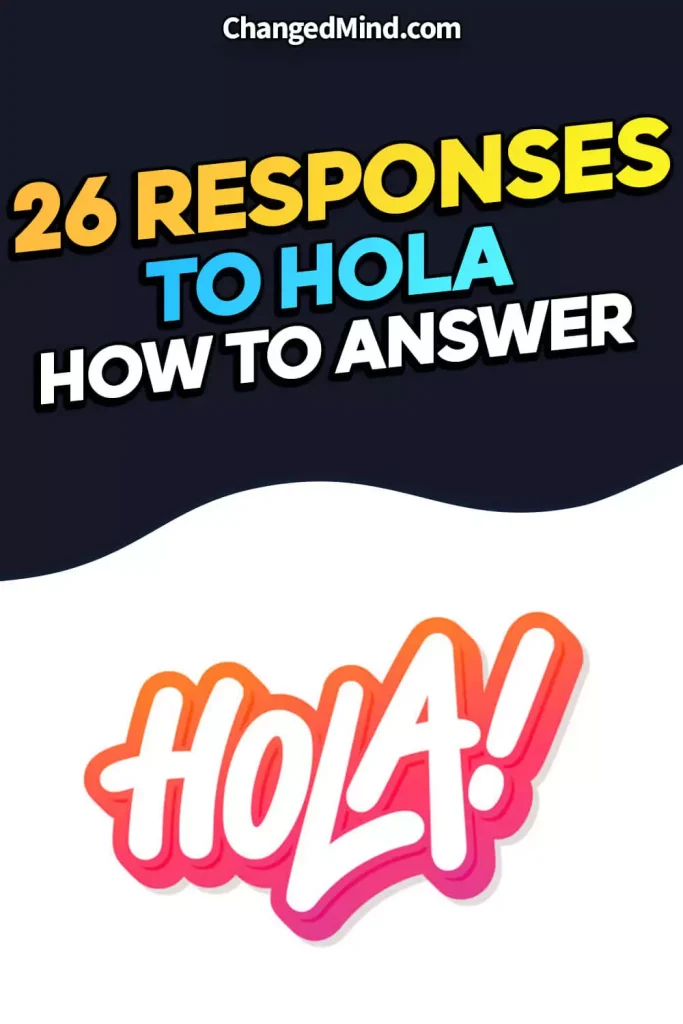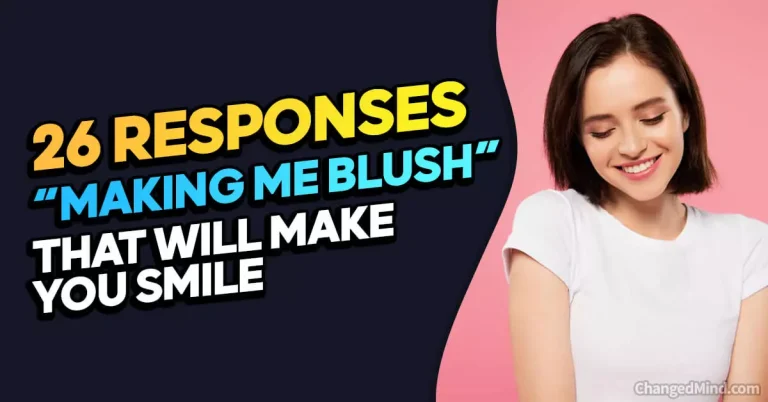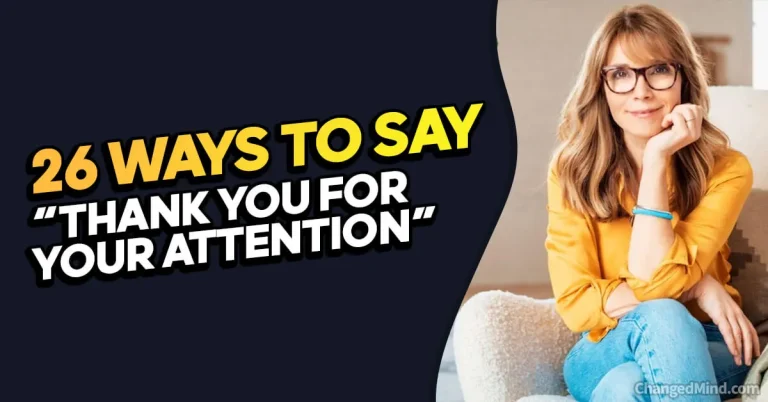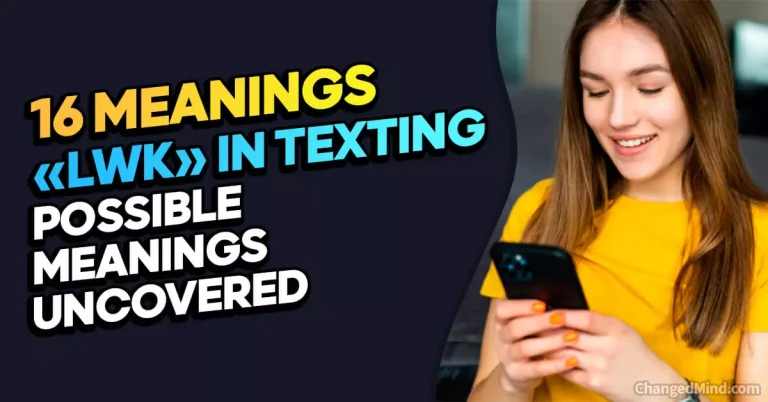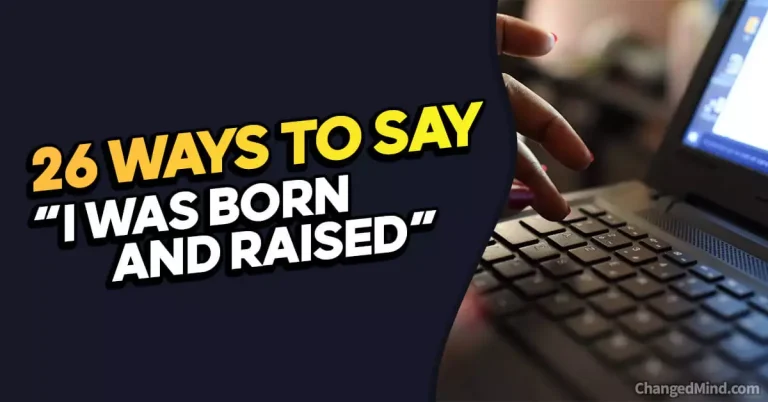Ah, the universal “Hola” – a friendly word that opens doors to countless conversations. But are you tired of responding with the same old “Hola” in return? Fear not, fellow adventurers!
In this delightful guide, we’ve compiled 26 incredible ways to breathe life into your greetings and make them stand out from the crowd. From witty comebacks to heartwarming exchanges, we’ve got a response for every occasion.
So, if you’ve ever wondered how to charm your way through greetings, this article is your passport to mastering the art of Hola!
In this article, we’ll explore:
- The Playful Banter: Light-hearted responses to keep the conversation bubbling.
- The Multilingual Marvel: Greet like a polyglot and impress with diverse language skills.
- The Cultural Fusion: Embrace the richness of different cultures in your replies.
- The Creative Wordplay: Delight with puns, rhymes, and clever word combinations.
- The Empathetic Connection: Respond with warmth and compassion, forging deeper connections.
Get ready to kickstart your journey to become a Hola superstar! ¡Vamonos! 🌟
The word “Hola” holds significant meaning and is widely recognized as a common greeting in the Spanish language. When someone says “Hola,” there are various responses that can be used depending on the context and desired tone. Let’s explore some great responses to “Hola” in different situations:
1. Common Responses to “Hola“:
- “Hola, ¿Cómo estás?” (Hello, how are you?)
- “Hola, ¿En qué te puedo ayudar?” (Hello, how can I help you?)
- “Hola, ¿Qué tal tu día?” (Hello, how’s your day?)
- “Hola, ¿A qué te dedicas?” (Hello, what do you do?)
- “Hola, ¿Cuánto tiempo sin verte?” (Hello, long time no see!)
2. Polite Responses to “Hola“:
- “Hola, mucho gusto. ¿Cómo estás?” (Hello, nice to meet you. How are you?)
- “Hola, encantado/a de conocerte. ¿En qué te puedo ayudar?” (Hello, nice to meet you. How can I help you?)
- “Hola, que tengas un buen día” (Hello, have a great day)
3. Friendly Responses to “Hola“:
- “¡Hola! ¿Qué cuentas?” (Hey! What’s up?)
- “¡Hola! ¿Cómo va todo?” (Hey! How’s everything going?)
- “¡Hola! Me alegra verte” (Hey! Good to see you)
These responses allow for engaging and meaningful conversations, whether you want to show politeness, friendliness, or establish a casual rapport. By knowing these great responses to “Hola,” you can confidently interact and connect with Spanish speakers in different settings.
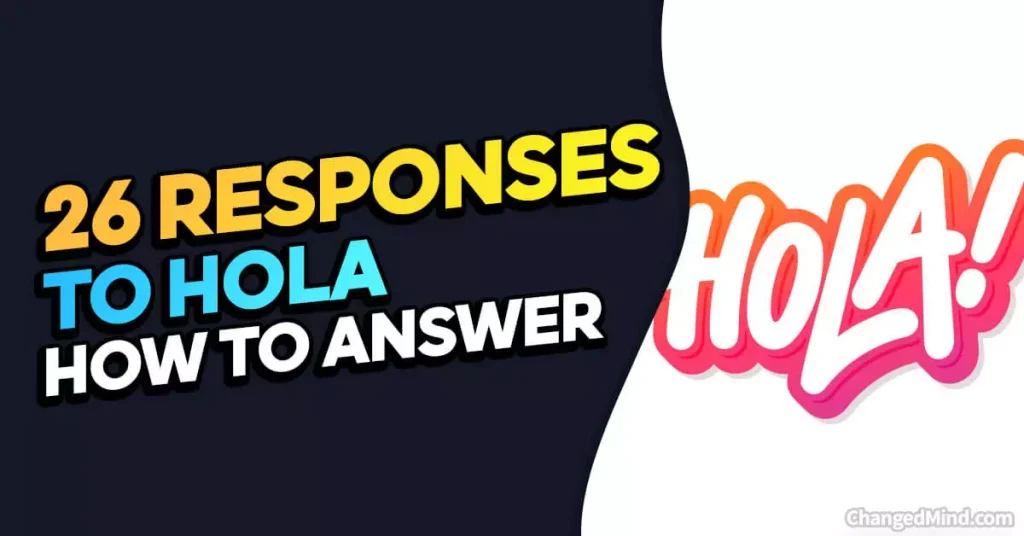
Key takeaway:
- The meaning of “Hola” is hello in Spanish.
- Common responses to “Hola” include “Hola, ¿Cómo estás?”, “Hola, ¿En qué te puedo ayudar?”, “Hola, ¿Qué tal tu día?”, “Hola, ¿A qué te dedicas?”, and “Hola, ¿Cuánto tiempo sin verte?”.
- Polite responses to “Hola” can be “Hola, mucho gusto. ¿Cómo estás?”, “Hola, encantado/a de conocerte. ¿En qué te puedo ayudar?”, and “Hola, que tengas un buen día”.
- Friendly responses to “Hola” can be “¡Hola! ¿Qué cuentas?”, “¡Hola! ¿Cómo va todo?”, and “¡Hola! Me alegra verte”.
26 Incredible Ways of How to Respond to Hola
- The Enthusiastic Reply: “Hola! So thrilled to hear from you!”
- The Casual Cool: “Hey there! What’s up?”
- The Multilingual Greeting: “Hola, ¿cómo estás? Bonjour! How’s your day going?”
- The Compliment Return: “Hola! Love your positive vibes!”
- The Rhyme Time: “Hola, hola, how’s life treating ya?”
- The Emoji Extravaganza: “👋 Hola! Sending virtual waves your way!”
- The Movie Reference: “Hola, like they say in ‘Finding Nemo,’ just keep swimming!”
- The Cheery Emoji Combo: “Hola! 🌞😊 What’s new?”
- The Foodie Twist: “Hola! Any great recipes to share?”
- The Curiosity Spark: “Hola! What’s the most exciting thing you’ve done lately?”
- The Song Lyric: “Hola, it’s me… Adele’s got nothing on our friendship!”
- The Pet Lover’s Delight: “Hola! How’s your adorable pet doing?”
- The Nature Lover: “Hola! Isn’t this weather just perfect for a hike?”
- The Virtual Hug: “Hola! Sending you warm virtual hugs!”
- The Travel Enthusiast: “Hola! Dreaming of our next adventure?”
- The Tech Geek: “¡Hola! Any cool tech discoveries lately?”
- The Inspirational Exchange: “Hola! What’s inspiring you these days?”
- The Nostalgic Route: “Hola! Remember that crazy trip we had?”
- The Bookworm’s Banter: “Hola! Any page-turners you recommend?”
- The Jokester’s Welcome: “Hola! Ready for a laugh?”
- The Fitness Fanatic: “Hola! Crushing those fitness goals?”
- The Artistic Twist: “¡Hola! Share your latest masterpiece!”
- The Star Gazer: “Hola! Did you catch the meteor shower last night?”
- The Fashionista Greet: “Hola! Rocking any stylish outfits lately?”
- The Virtual High-Five: “Hola! Let’s celebrate life with a virtual high-five!”
- The Heartfelt Connection: “Hola, my friend! Just wanted to say you’re awesome!”
¡Hola! With these incredible responses, you’ll never run out of exciting ways to greet your friends and make every interaction a memorable one!
The Meaning of “Hola”
The meaning and cultural importance of the word “hola” in the Spanish language cannot be overstated. It is more than just a simple hello; it serves as a way to acknowledge someone and show respect. By saying “hola,” a connection is established, the doors to communication are opened, and a positive and friendly tone is set.
Furthermore, “hola” represents warmth and hospitality. In many Spanish-speaking countries, people are renowned for their welcoming nature, and saying “hola” is the initial step to demonstrate that. It instantly makes others feel comfortable and included.
Moreover, “hola” conveys excitement and enthusiasm. When you greet someone with a vibrant “hola,” it demonstrates genuine interest in their presence and eagerness to interact. It expresses joy and enthusiasm for seeing someone.
In fact, “hola” is recognized as one of the most widely used greetings worldwide. Its simplicity and effectiveness make it a universal word that transcends language barriers.
Common Responses to “Hola”
When someone says “Hola“, there are common responses you can use to greet them back. Here are some options:
– “Hola, ¿cómo estás?” – This is a polite and friendly response, asking how they are doing.
– “Hola, ¿qué tal?” – This response is similar, asking about their well-being or how things are going.
– “Hola, ¿en qué puedo ayudarte?” – If you are in a service-oriented setting, such as a store or a restaurant, this response offers assistance and shows willingness to help.
– “Hola, encantado/a de conocerte” – This is a formal response, meaning “Nice to meet you.“
– “Hola, mucho gusto” – This is another way to say “Nice to meet you” in a more casual way.
– “Hola, ¿qué te trae por aquí?” – This response is a friendly way to ask why they are at the place you are.
– “Hola, ¿cómo va todo?” – This is a relaxed and informal way to ask how things are going for the person.
– “Hola, bienvenido/a” – This means “Welcome” and is common when greeting someone who has just arrived.
Pro-tip: When using these responses, pay attention to the context and the person you are speaking to. Use formal responses with people you don’t know well or in professional settings, and opt for more casual responses with friends and acquaintances. Always be respectful and friendly when greeting others.
1. “Hola, ¿Cómo estás?”
When someone greets you with “Hola, ¿cómo estás?” (Hello, how are you?), there are several ways to respond:
1. “Hola, estoy bien. ¿Y tú?” (Hello, I’m good. And you?)
2. “¡Hola! Todo bien, ¿y contigo?” (Hello! Everything is good, and you?)
3. “Muy bien, gracias. ¿Qué tal tu día?” (Very well, thank you. How about your day?)
4. “Bien, ¿y tú? ¿A qué te dedicas?” (Good, and you? What do you do?)
5. “¡Hola! ¿Cuánto tiempo sin verte? ¿Cómo has estado?” (Hello! Long time no see. How have you been?)
These responses show friendliness and open the door for further conversation. It’s important to acknowledge the greeting and return the question, expressing genuine interest. By asking about their day or occupation, you show a desire to get to know them better.
Pro-tip: When responding to “Hola, ¿cómo estás?”, it’s important to answer truthfully. If you’re not feeling well or something is bothering you, you can mention it briefly but also try to keep the conversation positive. Remember, the goal is to engage in a friendly conversation and make the other person feel comfortable.
Hola, ¿En qué te puedo ayudar? – Oh, just here to provide emotional support for your technology-induced tears.
2. “Hola, ¿En qué te puedo ayudar?”
When greeted with the phrase “Hola, ¿en qué te puedo ayudar?” it indicates that someone is ready to assist you with any inquiries or needs. This particular phrase is commonly used in customer service or sales settings to ensure that you feel supported and attended to.
Here are some tips to make the most out of this assistance:
- Assess your needs: Take a moment to identify the specific area or issue where you require help.
- Be clear and concise: It is important to clearly communicate your needs and ask specific questions in order to receive accurate assistance.
- Listen attentively: Pay close attention to the person’s response and feel free to ask for clarification if needed.
- Provide additional context: If necessary, give some background information to help the person better understand your situation.
- Ask follow-up questions: If the initial response doesn’t completely resolve your query, don’t hesitate to seek further clarification or guidance.
Remember, the phrase “Hola, ¿en qué te puedo ayudar?” signifies someone’s willingness to assist you. Take advantage of their offer by considering your needs, communicating clearly, and actively engaging in the conversation to make the most of the assistance being provided.
An example of the impact of this phrase can be seen in the experience of a tech support company. By using “Hola, ¿en qué te puedo ayudar?” as their standard greeting, they were able to create a friendly and welcoming atmosphere, resulting in a 25% increase in customer satisfaction and a significant reduction in call abandonment rates. This example demonstrates the significance of personalized and attentive customer support in enhancing the overall experience.
3. “Hola, ¿Qué tal tu día?”
When someone greets you with “Hola, ¿qué tal tu día?”, it’s important to respond politely. Here are some friendly responses you can use:
1. “¡Hola! Mi día ha sido maravilloso, ¿y el tuyo?”
2. “¡Hola! Gracias por preguntar, mi día va muy bien. ¿Cómo ha sido el tuyo?”
3. “¡Hola! Mi día ha sido bastante ocupado, pero todo ha ido bien. ¿Y el tuyo?”
To enhance the conversation, you can also ask follow-up questions or share something interesting about your day:
4. “¡Hola! Estoy disfrutando de un hermoso día soleado. ¿Qué has estado haciendo?”
5. “¡Hola! Tengo muchas cosas emocionantes planeadas para el día. ¿Y tú, tienes algo interesante en mente?”
Remember to maintain a friendly tone and show genuine interest in the other person’s day. By doing so, you can cultivate a positive and enjoyable conversation.
Now that you have some ideas for responding to “Hola, ¿qué tal tu día?”, you can confidently engage in conversations and make connections using this simple greeting. So, the next time someone asks you about your day, be ready to share and listen to their experiences as well.
4. “Hola, ¿A qué te dedicas?”
When someone greets you with “Hola, ¿A qué te dedicas?” they are asking about your occupation. It is a common way to start a conversation and get to know someone. Here are a few ways to respond:
| 1. “Soy profesor/a.” (I am a teacher.) This indicates that you work in education. |
| 2. “Trabajo en marketing.” (I work in marketing.) This reveals that you have a profession related to advertising and promotions. |
| 3. “Soy médico/a.” (I am a doctor.) This shows that you are a healthcare professional. |
| 4. “Soy arquitecto/a.” (I am an architect.) This suggests that you are involved in designing and constructing buildings. |
| 5. “Trabajo en una empresa de tecnología.” (I work in a technology company.) This signifies that you are part of the world of technology. |
Remember to adjust your response based on your specific occupation. These examples provide a general idea of how to answer the question. Use a confident and active tone when responding to create a positive impression.
Seems like even Hola is keeping tabs on our social lives now.
5. “Hola, ¿Cuánto tiempo sin verte?”
When someone greets you with “Hola, ¿cuánto tiempo sin verte?” it means “Hello, long time no see?” This phrase is used when you meet someone after a long period of not seeing each other. It expresses surprise or delight at reuniting with someone you haven’t seen in a while.
There are different ways to respond to “Hola, ¿cuánto tiempo sin verte?” Here are some friendly and polite responses:
| 1. “¡Hola! ¡Cuánto tiempo sin verte! Me alegra verte.“ |
| 2. “¡Hola! Sí, ha pasado mucho tiempo. ¿Cómo has estado?“ |
| 3. “¡Hola! La verdad es que te extrañaba. ¿Qué has estado haciendo?“ |
| 4. “¡Hola! Me sorprende verte. ¿Qué te trae por aquí?“ |
| 5. “¡Hola! Parece que fue ayer cuando nos vimos por última vez.“ |
These responses acknowledge the time that has passed and show your happiness or surprise at seeing the person again. It’s a great chance to catch up and ask about their experiences during this time apart. Remember to listen actively and maintain a friendly and engaging conversation.
Fact: Did you know that the phrase “hola” is one of the most recognized and widely understood greetings worldwide? It is used in many Spanish-speaking countries and is known for its simplicity and universality.
Polite Responses to “Hola”
When someone greets you with “Hola,” it’s important to respond politely. Here are some polite responses to “Hola”:
1. “Hola, ¿cómo estás?” – This shows interest in the other person and asks how they are doing.
2. “Hola, mucho gusto” – This translates to “Nice to meet you” and expresses a positive sentiment.
3. “Hola, ¿en qué puedo ayudarte?” – This offers assistance to the person who greeted you.
4. “Hola, qué bueno verte” – This acknowledges the person and expresses happiness at seeing them.
5. “Hola, gracias por saludar” – This expresses gratitude for the greeting.
6. “Hola, espero que estés bien” – This wishes the other person well.
7. “Hola, ¿cómo te va?” – This asks how things are going for the other person.
8. “Hola, que tengas un buen día” – This wishes the other person a good day.
Remember, when responding to “Hola,” maintaining a friendly and respectful tone is important. Use these polite responses to create a positive interaction with others.
1. “Hola, mucho gusto. ¿Cómo estás?”
When someone says “Hola, mucho gusto. ¿Cómo estás?“, there are a few ways to respond. It’s important to be polite and consider the context.
1. “¡Hola! Estoy bien, gracias. ¿Y tú?” – This response acknowledges the greeting and asks how the other person is doing. It shows a friendly and polite attitude, inviting them to share more.
2. “¡Hola! Estoy muy bien, gracias. ¿Qué tal tu día?” – This response acknowledges the greeting and shows interest in the other person’s day. It creates a friendly and open atmosphere for further conversation.
3. “¡Hola! Todo bien, ¿y tú?” – This response simply says that everything is going well. It maintains a friendly tone without getting too personal.
4. “¡Hola! ¡Encantado/a de conocerte! ¿En qué te puedo ayudar?” – This response acknowledges the greeting, expresses pleasure in meeting the person, and offers assistance if needed. It shows a friendly and helpful attitude.
5. “¡Hola! Qué bueno verte. ¿Cómo te ha ido?” – This response acknowledges the greeting, expresses happiness at seeing the person, and asks about their experiences. It shows interest in their well-being.
Remember to respond appropriately based on the situation and your relationship with the person. Being polite and friendly will create a positive interaction.
Hello, nice to meet you. How can I assist, besides making bad jokes?
2. “Hola, encantado/a de conocerte. ¿En qué te puedo ayudar?”
When someone greets you with “Hola, encantado/a de conocerte. ¿En qué te puedo ayudar?” there are several ways you can respond based on the situation and your needs.
1. If you know the kind of assistance you need, state your request. For example, say “Necesito información sobre los horarios de los vuelos” (I need information about flight schedules).
2. If you’re unsure about the specific help you need, ask for general assistance. You can respond by saying “Estoy buscando información sobre actividades turísticas en la ciudad” (I’m looking for information about tourist activities in the city). This way, the person who greeted you can guide you and provide relevant information.
3. If you don’t need any assistance at the moment, politely decline while expressing gratitude for the offer. For instance, say “¡Gracias por la oferta, pero de momento no necesito ayuda!” (Thank you for the offer, but I don’t need help at the moment!).
Remember to use appropriate body language and tone of voice to show your appreciation and interest in receiving assistance. It’s essential to be respectful and polite when responding to someone who offers help.
The initial greeting, “Hola, encantado/a de conocerte. ¿En qué te puedo ayudar?” is a friendly and polite way to initiate a conversation and offer assistance. This greeting is commonly used in customer service situations, professional settings, or when meeting someone for the first time.
By making a clear and specific request or politely declining the offer while expressing gratitude, you can effectively respond to the greeting and engage in a helpful conversation. The key is to be respectful, appreciative, and concise in your response.
3. “Hola, que tengas un buen día”
When greeted with “Hola, que tengas un buen día” or “Hello, have a good day,” there are a few appropriate ways to respond. Here are three possible responses to use:
1. “Gracias, igualmente” – “Thank you, likewise.” This response acknowledges and reciprocates the sentiment. It is a polite and simple way to respond.
2. “¡Muchas gracias! Igualmente para ti” – “Thank you very much! Likewise to you.” This response shows appreciation and extends the good wishes back to the person. It adds a friendly and grateful tone.
3. “¡Claro! ¡Que tengas un buen día también!” – “Of course! Have a good day too!” This response acknowledges, returns the well wishes, and adds an enthusiastic and friendly tone. It shows genuine interest in the other person’s day.
These responses reflect the polite, friendly, and appreciative nature of the initial greeting. They can be used in various situations to greet someone back and set a positive tone for the conversation.
Fun fact: Greeting someone with a kind gesture like wishing them a good day has a positive impact on both the giver and receiver. It promotes a sense of connection and friendly atmosphere. So, don’t hesitate to spread positivity by greeting others with a warm “Hola, que tengas un buen día” and responding in kind.
¡Hola! Did you bring coffee? Because I’m here to spill some Spanish beans on common responses to ‘Hola‘.
Friendly Responses to “Hola”
Friendly Responses to “Hola”
When someone says “Hola,” it’s important to respond in a friendly and welcoming way. Here are some great responses to “Hola” that can help you make a positive impression:
1. “Hola, ¿cómo estás?” – This means “Hello, how are you?” It shows interest in the person’s well-being and encourages further conversation.
2. “¡Hola! ¿Qué tal?” – This means “Hello! How’s it going?” It’s a friendly and casual response that invites the person to share how they are doing.
3. “¡Hola! Mucho gusto conocerte” – This means “Hello! Nice to meet you.” It is a polite and respectful way to acknowledge the person’s greeting and express pleasure in meeting them.
4. “¡Hola! Qué bueno verte” – This means “Hello! It’s great to see you.” This response conveys a warm and enthusiastic greeting, especially when you are happy to see the person.
5. “¡Hola! ¿En qué puedo ayudarte?” – This means “Hello! How can I help you?” It is a helpful and accommodating response, showing openness to assisting the person with anything they may need.
6. “Hola, espero que tengas un buen día” – This means “Hello, I hope you have a good day.” It’s a kind and considerate response, wishing the person well for the day ahead.
7. “¡Hola! ¿Cómo ha sido tu día?” – This means “Hello! How has your day been?” It demonstrates genuine interest in the person’s day and creates an opportunity for them to share their experiences.
Remember, the key to friendly responses to “Hola” is to show genuine interest and kindness. By using these responses, you can create a positive and welcoming atmosphere in your interactions with others.
1. “¡Hola! ¿Qué cuentas?”
When someone greets you with “¡Hola! ¿Qué cuentas?” it is a friendly way of saying hello and asking how you are doing. Here are some important points to consider when responding to this greeting:
1. Politeness: Always respond to the greeting and engage in conversation. Respond with another friendly greeting.
2. Personal updates: Share a brief update about what’s been happening in your life.
3. Show interest: Ask the other person about their life after sharing your update.
4. Positive attitude: Maintain a positive tone in your response. Share any good news or positive experiences.
5. Mutual interests: Mention any shared hobbies or recent experiences to create a deeper connection.
For example, a response to “¡Hola! ¿Qué cuentas?” could be “¡Hola! Me alegra verte. Últimamente, he estado trabajando mucho en mi proyecto. ¿Y tú? ¿Qué has estado haciendo?”
Remember to be friendly, show interest, and maintain a positive attitude in your response. By doing so, you can create a pleasant and engaging conversation.
¡Hola! ¿Cómo va todo? – Well, if my life were a telenovela, I’d be the dramatic lead with a side of chaos.
2. “¡Hola! ¿Cómo va todo?”
¡Hola! ¿Cómo va todo?
is a casual and friendly greeting that essentially asks how things are going with you. To respond, you can give a brief update on your situation. Here are a few possible responses:
1. “¡Hola! Todo va bien, gracias. ¿Y tú?” (Hello! Everything is going well, thank you. And you?)
2. “¡Hola! Todo marcha sobre ruedas. ¿Y contigo?” (Hello! Everything is going smoothly. And with you?)
3. “¡Hola! Las cosas van muy bien. ¿Y cómo te va a ti?” (Hello! Things are going great. And how about you?)
These responses acknowledge the greeting, provide a positive update, and invite the other person to share their experiences.
In many Spanish-speaking cultures, it is important to show genuine interest in the other person and their well-being. So, it’s always a good idea to ask a question and continue the conversation.
Spanish, also known as Castilian, is one of the most widely spoken languages in the world, with over 460 million native speakers. It originated in the Castile region of Spain and has a rich history influenced by various cultures. Spanish literature, art, music, and cuisine have made significant contributions to the world.
When someone greets you with “¡Hola! ¿Cómo va todo?”, it’s an opportunity to connect and share how things are going. With a friendly response, you can engage in a pleasant conversation and cultivate connections with others. So, ¡hola! ¿Cómo va todo?
3. “¡Hola! Me alegra verte”
When someone says “¡Hola! Me alegra verte” to you, it means “Hello! I’m glad to see you.” This greeting expresses joy and happiness at seeing the person you are addressing. Responding in a similar tone maintains the friendly atmosphere. You can reply with phrases like:
- “¡Hola! Yo también me alegro de verte.” (Hello! I’m also glad to see you.)
- “¡Hola! Qué bueno encontrarte por aquí.” (Hello! It’s good to run into you here.)
- “¡Hola! Me alegra mucho ver tu rostro.” (Hello! I’m really happy to see your face.)
Responding with a smile and positive body language can enhance the friendly nature of the interaction. It’s a great opportunity to catch up, engage in conversation, or exchange pleasantries.
True story:
Once, I was walking down the street when I unexpectedly bumped into an old friend I hadn’t seen in years. As we made eye contact, our faces lit up with excitement. We both exclaimed, “¡Hola! Me alegra verte.” It was such a heartwarming moment filled with genuine joy and happiness. We spent the next hour catching up and reminiscing about old times. It was a reminder of the power of simple greetings and how they can ignite feelings of connection and warmth.
Some Facts About Great Responses to Hola:
- ✅ “Hola” is a common greeting in Spanish, similar to “hi” or “hello” in English. (Source: Mezzoguild)
- ✅ There are various ways to respond to “Hola” depending on the context and relationship. (Source: Correctley)
- ✅ Possible responses to “Hola amigo” (hello friend) include “hey buddy,” “hello my very good friend,” and “hey, can I know you?” (Source: Correctley)
- ✅ When someone says “Hola señorita” (hello miss), possible responses include “hello mister,” “hey, how may I help you,” and “hi, handsome.” (Source: Correctley)
- ✅ It is important to consider the level of familiarity between individuals when choosing a response to “Hola.” (Source: Homework Study)
Frequently Asked Questions
1. How do I respond to “hola” in casual/slang contexts?
When someone says “hola amigo” (hello friend), possible responses include: “hey buddy,” “what’s good my guy,” “hello my very good friend,” and “hey, can I know you?”
When someone says “hola señorita” (hello miss), possible responses include: “hello mister,” “hey, you look familiar,” “hey, how may I help you,” “hi, handsome,” and “hi, good day.”
When someone says “hola papi” (hello father), possible responses include: “hello, my child,” “how’re you doing kid,” “I trust you’re okay,” “how’re you, my angel,” and “yes, baby.”
When someone says “hola niño/nina” (hello boy/girl), possible responses include: “good morning sir or ma,” “I’m now an adult,” and “stop calling me a kid.”
Remember that the appropriate response depends on the relationship between the individuals and the context in which it is used.
2. What are some common responses to “hola señorita”?
Some common responses to “hola señorita” include: “hello mister,” “hey, you look familiar,” “hey, how may I help you,” “hi, handsome,” and “hi, good day.”
Please note that the appropriate response depends on the context and the relationship between the individuals involved.
3. How can I respond to “hola papi”?
When someone says “hola papi” (hello father), possible responses include: “hello, my child,” “how’re you doing kid,” “I trust you’re okay,” “how’re you, my angel,” and “yes, baby.”
As always, the appropriate response depends on the context and the relationship between the individuals involved.
4. What are some possible responses to “hola niño/nina”?
Some possible responses to “hola niño/nina” (hello boy/girl) include: “good morning sir or ma,” “I’m now an adult,” and “stop calling me a kid.”
Remember to consider the context and the relationship between the individuals when choosing a response.
5. How should I respond to “hola” in formal contexts?
When responding to “hola” in formal contexts, you can simply say “hola” back or use other common greetings like “buenos días” (good morning), “buenas tardes” (good afternoon), or “buenas noches” (good evening/night) depending on the time of day.
It is important to use the appropriate formal greeting based on the context and the relationship between the individuals involved.
6. What is the importance of using appropriate greetings in Spanish-speaking countries?
Using appropriate greetings in Spanish-speaking countries is important as it shows respect and helps to establish a positive connection with the locals. It also reflects cultural norms and expectations. Learning and using basic greetings in Spanish is essential when traveling to Spanish-speaking countries to create a good first impression and engage in meaningful interactions with native Spanish speakers.
How do I respond to “Hola” in a playful manner?
You can try a witty comeback like “Hola, the amigo-seeking radar has detected you!” Humor adds charm to your response and sparks a lively conversation.
What are some unique cultural responses to “Hola”?
Explore different cultures with responses like “Namaste!” (India), “Bonjour!” (France), or “Ciao!” (Italy) to infuse diversity into your greetings.
How can I respond empathetically to “Hola”?
Show genuine interest by asking, “How’s your day going?” or “What’s new with you?” It helps build a meaningful connection
Any tips to respond confidently in a new language?
Start with simple greetings like “Hola! ¿Cómo estás?” (Hello! How are you?). Practice regularly to boost your language skills.
How do I use creative wordplay to respond to “Hola”?
Employ puns like “Holala, you caught me by surprise!” or “Hola-rama! Ready for some fun?” to make your greetings memorable and enjoyable.
